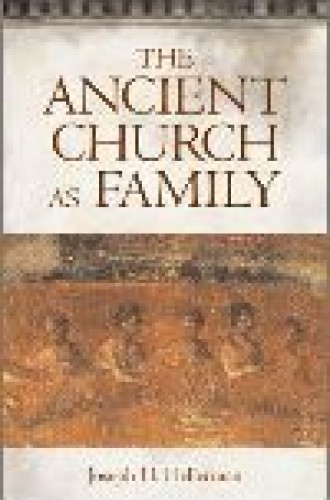Family ties
Stephen Barton is more concerned with biblical interpretation than with detailing first-century family life or attitudes about sexuality. His goal is not to reconstruct the shape of the New Testament–era family but to provide “theological interpretation” that is “historically informed.”
In debates over sexuality and sexual ethics, the right place to begin is not with texts of the Bible, as if a passage could settle a debate, but by asking: “What kind of people do we need to be to interpret the Bible wisely?” Such a question, Barton argues, avoids biblicism while still allowing us to read the Bible as life-giving and liberating. His position reminds me of a startling assertion by the most challenging of European feminist exegetes, Lydia Schottroff (author of Impatient Sisters: A Feminist Social History of Early Christianity): “For me, the most important school of justice I know is the biblical tradition.” Barton wants to read the Bible with a hermeneutic of trust, not of suspicion.
He begins biblical interpretation with “the Christian vision of God as a Trinity of love, and argues that “the Trinitarian sociality of God is the basis for true creaturely sociality. The desire we have for union . . .—whether the union of solidarity, or of friendship, or of intimacy, or of sexual intercourse—is a desire which expresses the divine nature within us.” Suggesting how we may live today as families in light of the New Testament, Barton emphasizes the incarnation, the Word become flesh. The Incarnate Word begins his public ministry at a wedding and ends it by providing for his mother.
In the introduction to his chapter on the Gospel of John, Barton writes that the church is called to witness to the life together of people of every kind, doing so by being itself in unity, holiness, catholicity and apostolicity—four descriptors from the fourth-century Constantinopolitan Creed. A postmodern exegete, Barton advocates interpreting scripture, both Old and New Testaments, in light of the Christian confessions.
By itself, historical-critical interpretation not only avoids theology but serves the interests of liberal individualism. For example, social historians present the first-century family as a microcosm of the patriarchal city-state. They argue that its system of authority was hierarchical and nonegalitarian; slavery was taken for granted. Barton objects that this interpretation is minimalist, consisting of a few, mostly sociological commonplaces which allow contemporary readers to see their own family relationships by contrast as personalist and meaningful.
For his part, Barton insists that the New Testament witnesses to the corporate and institutional dimensions of Christian discipleship. He writes about the communal character of Christianity, about Christian community in John and in 1 Corinthians. In chapter 11, however, Barton abandons sociology and ecclesiology, attacks the Enlightenment practice of tolerance and argues that the New Testament promotes not evenhanded tolerance but zeal for God, not human reason but revelation. He ignores the fact that Luke-Acts does pick up the Greco-Roman emphasis on phil-anthropia (love of humanity), as opposed to antisocial mis-anthropia. But Barton is correct in pointing out that despite the warnings of several generations of New Testament scholars about “early Catholic” institutionalization, the earliest Pauline “house churches” were in fact quite concrete institutions.
Dealing with problem texts raises the key question of the relationship between church and culture, of how the already given structures of social existence are to be renewed in light of membership in the body of Christ. Barton cites the household codes in the New Testament that subordinate wives to husbands and slaves to masters as examples. Because Romans were obsessively concerned with rank within the household, the Roman houses in which early Christians typically worshiped opposed the egalitarian values that Christians proclaimed in their baptismal theology. And Christians often acted out these hierarchical Roman architectural and cultural norms. Since this is so, one must ask whether Barton’s emphasis on the ecclesial dimension of faith is too optimistic.
Barton recommends Rudolf Bultmann’s approach to outmoded cosmology and mythology: responsible interpretation involves ongoing engagement between the reader and the text in openness to God’s justifying grace in Christ. The true meaning of a text is never static. The text does not have just one, literal meaning, but may have meanings beyond that intended by the original author.
Talk about the family must be eschatological. It should not hark back to antique family patterns but engage in creative, theological interpretation that speaks to family life today. In Matthew, “the kingdom of heaven is an eschatological reality,” which means that “human relations of superordination and subordination (including relations between women and men) can ever only be provisional, open always to new revelations of divine wisdom.” Reflection on the Gospel of John, too, must “have a strong eschatological dimension; . . . it will demand of us readers and hearers an openness to ongoing judgment and transformation, both individually and in our life together.” Paul situates the lives of the Corinthians in an eschatological perspective, between the cross at the letter’s opening and the resurrection toward the letter’s end. He wants to see the Corinthians’ participation in the kingdom of God embodied in the life of the community, an alternative society.
Unlike Barton, Joseph Hellerman emphasizes the social sciences. That early Christians thought of their community as a surrogate family is, Hellerman thinks, the main reason for the rapid growth and spread of Christianity. A “surrogate family” is “a social group whose members are related to one another neither by birth nor by marriage, but who nevertheless a) employ kinship terminology to describe group relationships and b) expect family-like behavior to characterize interactions among group members.”
Hellerman presents a masterful outline of ten social characteristics in five types of first-century voluntary organizations comparable to early Christian groups. In addition to the Christian ekklesia, Hellerman describes professional, domestic and cult associations, philosophical schools and Jewish synagogues. He evaluates their voluntary nature, religious orientation, common meals, translocal nature, social inclusivity, structural egalitarianism, focus on study, opposition to the dominant culture, exclusive allegiance and familial emphasis. He argues that only Christian groups were strong in all these areas.
Hellerman’s chapter on “Mediterranean family systems” is one of the clearest available expositions contrasting “kinship then and now.” However, Hellerman follows a school of New Testament interpreters who assume that “peasant society in the Mediterranean region has remained relatively static for the two millennia since the early Christian documents were written.” Recent scholarship has made that assumption problematic. Has a common culture really remained static among the various peoples of the Mediterranean (from Italians to Arabs) for the two millennia that have seen the rise of Christianity, the expansion of Islam, the Crusades, the rise and fall of several seagoing European empires, and two world wars?
Hellerman argues that Jesus intended to form a distinct community of followers, whose commitment to him generated tensions with their patrilineal families. While Jesus’ ideas generally differed from Israelite ideas only in degree rather than in basic substance, sayings like “Whoever comes to me and does not hate his own father . . . cannot be my disciple” and “Follow me, and let the dead bury their own dead” are distinctive and show a radical change of loyalties. The defining problem faced by all Jewish groups in this period was gentile occupation. What distinguishes Jesus from other leaders of Jewish sects is his treatment of outsiders, using table fellowship to undermine boundaries.
Paul’s epistles exhibit a cluster of kinship terms, especially when he is discussing a community’s violation of the norms of kinship. As various scholars have pointed out, Paul uses Greco-Roman rhetorical forms, but uses their language to advocate the opposite of what such speeches usually commend. Instead of solidifying hierarchy, Paul challenges the strong to lower themselves to serve the weak. Hellerman adds that kinship terminology is generally absent from the Greco-Roman speeches on which Paul models 1 Corinthians, an epistle especially marked by such terminology.
Paul’s greatest innovation is that he presents himself as the Corinthians’ father. He employs this metaphor primarily to encourage imitation of his behavior and only secondarily to stress obedience. A plurality in leadership characterized Paul’s congregation. Paul encourages familial reciprocity when he demands that Corinthian Christians not go to court against one another and when he encourages greater loyalty to the surrogate, church family than to marriage. Kinship language is especially dense in 2 Corinthians, where Paul encourages the Corinthians to contribute to the support of their brothers and sisters in Judea. Hellerman concludes that the writers he has surveyed seldom use the kinship metaphor in the service of power. In Roman society it was difficult to maintain concern for those lower in the social order or to encourage mutuality, but Paul did both.
Hellerman’s account of the rapid spread of Christianity is less successful, for he neglects theological issues. Religious traditions that did not make the transition from national cult to world religion form an instructive contrast to early Christian mission. For example, As R. Merkelbach has pointed out, Isis, despite being the goddess most widely worshiped during the rise of Christianity, remained identified with a particular country, Egypt, and with one ethnic group, the Egyptians. The Egyptian clergy remained hereditary and circumcised, and the theologians did not transcend local agricultural concerns, such as the flooding of the Nile that fertilized Egypt. They did not formulate philosophical explanations of the cosmos, as the brilliant theologians Clement of Alexandria, Origen, Tertullian and Cyprian did for Christianity.
When Plutarch and Porphyry began the philosophical interpretation of the Isis cult, the priests of Isis rejected their efforts, insisting rather that traditional rituals remain sacrosanct. Porphyry argued that prayers in Egyptian (Coptic) had no meaning to Greek worshipers, and that the gods are not Egyptian. But Egyptian priests from the second to the fourth century c.e. isolated themselves. Only 29 letters were needed to read Christian texts, but a thousand signs were needed to read Isis texts. The priests of Isis insisted on the power of Egyptian hieroglyphs. In contrast, Hellenistic Jews translated the Bible into Greek, and Christians translated their expanded canon into many other languages on behalf of world mission.
Hellerman, in company with most of the recent social historians of early Christianity, neglects these crucial accomplishments. Another ideological-theological element that he does not stress enough is Christianity’s rejection of astrology. An emphasis on fate determined by the stars finally destroys the idea of God’s independence; therefore Christian theologians denied astrology completely. A final theological triumph of early Christian theology came in response to the question “Can one philosophically affirm a unified meaning in the cosmos? Is there one God?” Here adherents of Isis and Jesus both faced difficulties. The first worshiped three persons, Isis, Osiris and Horus, and Christians seemed to worship three persons, Jesus, the Father and the Spirit. Christian theologians successfully took on the task of arguing that Christians remained monotheists.
As a result of all these factors, the worship of Isis-Sarapis remained imprisoned in the land of its origins, despite the deep religious emotions associated with worship of the loving mother, Isis. Christianity became a world religion partly because Christians seized the opportunity to modernize their cult by combining it with Platonic philosophy.
All this is relevant to our contemporary struggles: Will we further modernize our worship of God by finding theological ways to articulate and worship the feminine in God? The rise or fall of Christianity in the 21st century will depend in part on the answer to that question.






